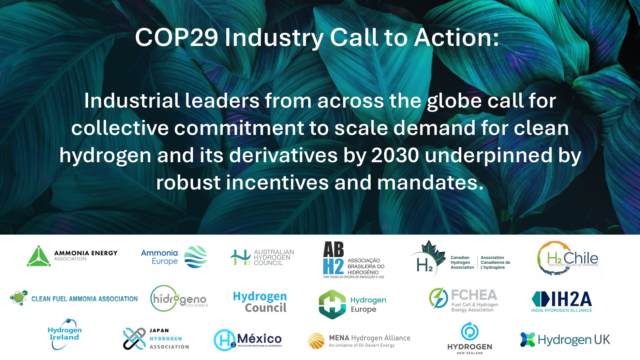Call to action: what governments must now do to support demand
By Trevor BrownJulian Atchison on November 28, 2024
As climate negotiators from around the world gathered in Baku for COP29, the AEA and like minded organizations delivered two urgent calls to action. These documents outline practical actions needed from governments in the next 1-2 years to stimulate demand for clean hydrogen and ammonia. Now through 2025 and 2026, the AEA, its coalition partners, and all our industry members need to channel these messages into national and local policies to scale demand for clean molecules.
Industry calls on governments to take practical actions in the next two years

Click to expand. The AEA joins the Hydrogen Council and nearly two dozen other industry associations in calling for urgent, practical action to scale hydrogen development by 2030.
The AEA helped to build a coalition of nearly two dozen industry associations led by the Hydrogen Council calling for governments to take urgent action in the next two years, in order to scale demand for clean hydrogen and derivatives by 2030. Although global investment in hydrogen has grown seven-fold in the last four years (resulting in $75 billion in committed capital across 434 large-scale projects that have reached a financial investment decision (FID), according to the document), much more is needed to reach our 2030 targets.
The coalition calls on governments around the world to:
- accelerate demand-side measures by setting and implementing incentives and targets for clean hydrogen deployment in key end-use sectors,
- support midstream infrastructure, including retrofitting and repurposing projects,
- advance implementation and reinforcement of supply side incentives, including upstream renewable energy projects,
- increase public procurement in hydrogen projects,
- speed up permit-granting processes,
- include hydrogen in national energy transition plans, particularly NDCs due to be submitted in 2025,
- advance public-private partnerships beyond MOUs and support blended finance,
- and accelerate the adoption of global standards and mutual recognition of certification schemes, building on progress made at COP28.
If implemented in the next two years, these practical actions could lead to cost-effective matching of supply and demand of hydrogen and derivatives on a global scale by 2030.
Business and finance urge governments to strengthen policy frameworks between COP29 and COP30
Click to expand. Mission Possible Partnership and the Industrial Transition Accelerator are leading a coalition of signatories calling for urgent action to realize the significant pipeline of industrial, low-carbon projects yet to reach FID.
The AEA also supported a call to unlock demand for low-carbon products led by the Industrial Transition Accelerator (ITA). Mission Possible Partnership and the ITA are tracking a growing pipeline of industrial projects – nearly 700 across aluminium, cement, chemicals, steel, aviation and shipping – with less than 20% operational or having secured FID. More than half of the remaining pipeline of projects has been awaiting an investment decision for at least two years.
To break the stalemate, the signatories in the ITA’s open letter are calling on governments to strengthen their policy frameworks in the 12 months ahead (between COP29 and COP30), to stimulate additional demand for low- and near-zero carbon materials, chemicals and fuels. Key stakeholders behind this call are over 700 financial institutions from more than 50 countries, joined in coalition through The Glasgow Finance Alliance for Net Zero (GFANZ), which was launched at COP26.
Similar to the practical actions called for by the Hydrogen Council coalition, the ITA calls on governments to deploy a range of policy measures to unlock demand and level the playing field, including:
- supporting global carbon pricing and fuel standard measures,
- setting and enforcing mandatory quotas for low- and near-zero-carbon fuels and products that become stricter over time,
- setting mandatory targets for low- and near-zero-carbon materials in public procurement,
- and setting stringent and progressively tightening limits on whole life carbon (including embodied carbon) in key product standards.
Alongside the open letter, the ITA has published a “Green Demand Policy Playbook”, setting out a range of evidence-based policy measures available to governments. MPP and ITA note that these policies are highly synergistic, and can drive decarbonisation for multiple upstream sectors.
We already have the technologies we need to decarbonise our economies and prevent further climate breakdown, and now we have the projects to bring them to market. But we’ve reached a stalemate between producers and buyers that cannot be broken while buyers are not incentivised to purchase green products that still compete against cheaper, higher-carbon products…We have a 2-year window of opportunity remaining to start construction of green production facilities for them to be up and running by 2030. There is no time to lose.
Faustine Delasalle, Executive Director of the ITA Secretariat and Chief Executive Officer of the Mission Possible Partnership in her organisation’s official press release, 14 Nov 2023